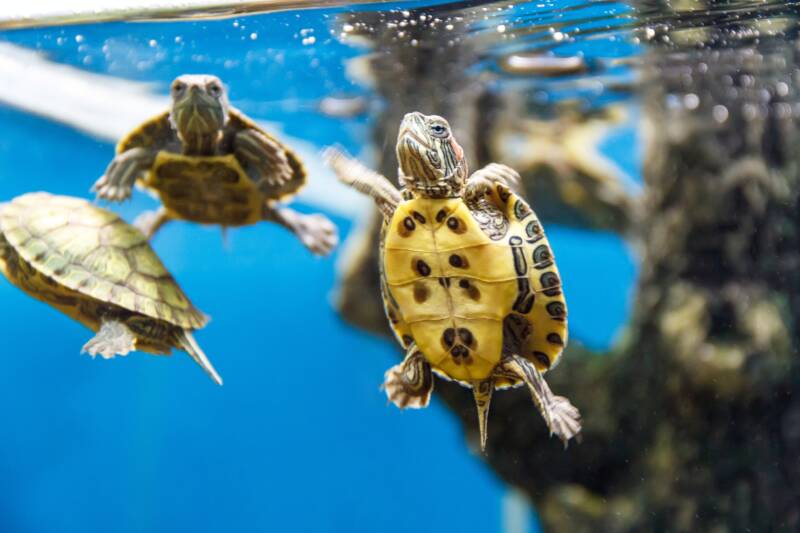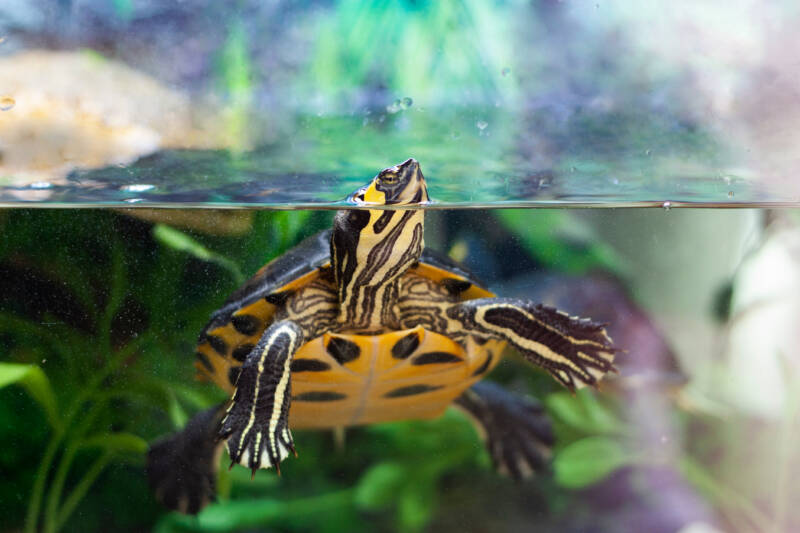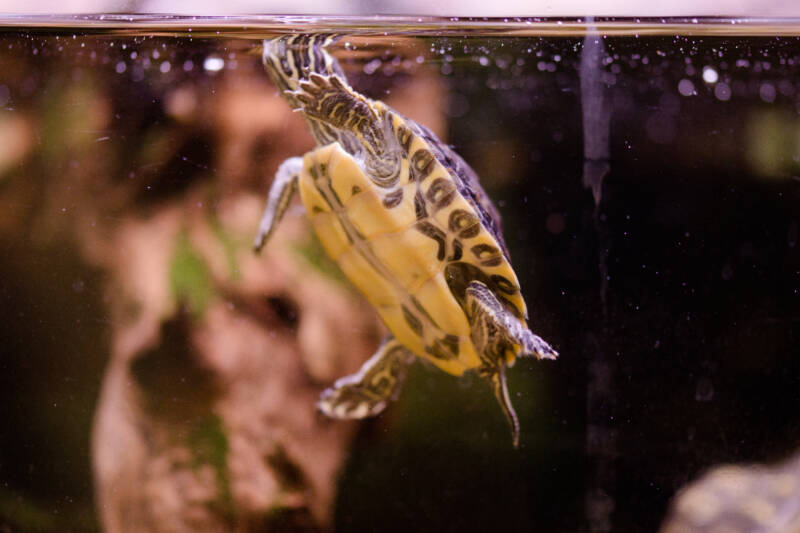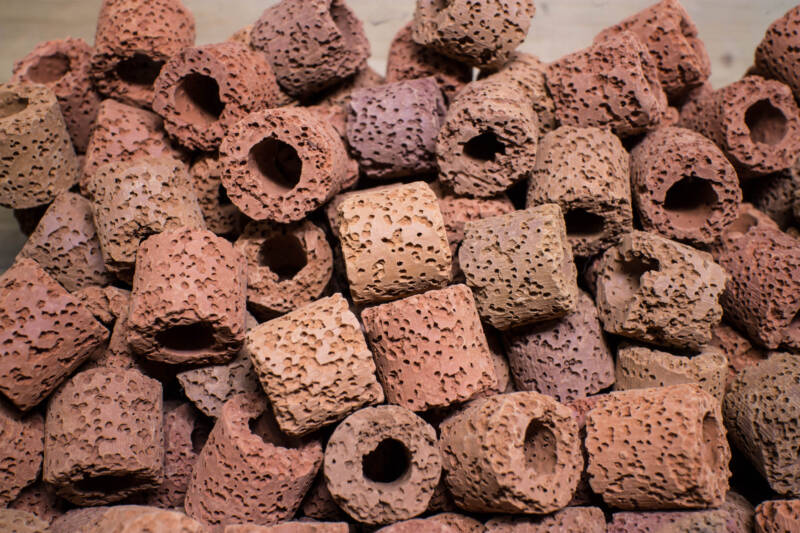in this post we explore some of the best Filter for Turtle Tank
Keeping turtles is extremely cute and rewarding. These are amazing creatures that have an ancient history and that are endlessly entertaining and endearing to watch.
But with that said, they can also be somewhat fragile.

And with a lot of misinformation out there, knowing how to set up your turtle tank for the first time can be fraught with difficulty and stress. One big decision you will need to make is what kind of filter to get.
In this article, we will examine what the best filter for turtle tank use is and how to make sure your turtle is happy and clean.
[toc]
What Does a Turtle Tank Filter Do?

Choosing the right turtle tank filter is a very important process, and yet it’s one that many people don’t fully appreciate.
In fact, there are some sources on the web that report you do not actually need a turtle tank filter! This is misinformation, and it can, of course, be harmful to your little shelly.
All aquariums require a filter, in fact, if you want to keep the residents as happy and healthy as possible.
Think about it this way: in the wild, your turtle would have the entire ocean to roam around in. Should your turtle shed some skin, drop some food, or pass some stool, it could then swim away and leave that mess behind.
Even if the turtle stayed put, the smell and particles would have an entire ocean to dissipate into and dissolve in. Moreover, countless other processes and aspects of the ecosystem would also help to deal with this.
Tiny fish and worms would come and eat those droppings. The tide would flush those elements out. And sponges would act as natural filters.
Tank water is different. Your tank water is sealed around your turtle inside a small container, and that detritus has no way of escaping.
This can leave your turtle completely trapped in with those smells and bacteria that grow on leftover food and stool.

The biggest danger, and the most important reason to invest in a filter, is ammonia (a by-product that is produced by the turtle’s feces). This can be toxic and even small amounts can become dangerous quickly.
Thus, the job of the best water filters is not only to filter particles out of the water but also to help convert the dangerous ammonia into the far more inert nitrate.
That nitrate causes no harm to your turtle and will be removed when you handle basic tank maintenance. How does this happen?
Well, the filtration process will include the “nitrogen cycle“. This is actually handled by live bacteria, that break down the ammonia.
Filter media (the substrate that is inserted into the filter system) controls this “biological filtration”.
Best Turtle Tank Filters You Can Buy Today
This list includes some of the best filtration systems available right now:
1. Polar Aurora Free Media 4-Stage External Canister Filter
This canister filter has four separate media trays that can handle any filtration media of your choice. It contains an adjustable spray bar, which allows you to alter the output flow – a handy feature.
The system also includes a self-priming pump that can eliminate the need for manual siphoning. That single valve priming pump easily disconnects for maintenance, too.
Other features include a 9 Watt UV sterilizer which can help to reduce algae and encourage clearer water.
The system comes with a filter sponge, activated carbon, ceramic rings, and bio-balls.
For the best results, you may choose to only use the activated carbon at certain points. These options are great for chemical filtration, however.
This filter system is well-made, very powerful, and highly reliable.
It boasts a quiet operation (almost silent with the use of the skimmer intake cap), and it’s easy to find replacement parts. For all these reasons, it’s a great option for any turtle tank.
Pros
- Very powerful
- UV sterilizer
- Multiple trays for filter materials
- Extremely quiet
Cons
- Creates some bubbles due to a smaller surface skimmer intake
- Comes with a chemical filter option that you may choose not to use
2. Fluval 207 Perfomance Canister Filter
This is another powerful canister filter that is simple and effective.
Following a recent redesign, this filter uses fewer pumps to achieve the same effect, reducing maintenance and resulting in a more efficient system.
Features include dual action locking clamps that allow for quick and easy release and attachment and a raised lip for efficient operation.
Pros
- Powerful and reliable
- Very quiet – especially since the recent update
- Very efficient
Cons
- Not as many features as the Polar Aurora
- Canister needs to be kept below the level of the tank
- Quite complex to assemble
3. MarineLand Penguin 350 BIO-Wheel Power Filter
And now for something a little different! This highly affordable filter works by using a rotating bio wheel that will allow for excellent biological filtration and high (literal) turnover.
This filter also uses a multi-stage filtration process, which allows you to combine mechanical, chemical, and biological media in a single system.
The system is available in a variety of different sizes to suit different flow rate requirements, ranging from 75Gh up to 350Gh!
Pros
- A powerful alternative to a canister filter
- Extremely effective three-stage filtration
- Creates a peaceful noise
- More adaptable to different turtle tank setups than many alternatives
- Easy to control flow rate
Cons
- Loud! While the sound is pleasant, it certainly isn’t subtle
- Moving wheel means another element to potentially get damaged
4. Penn Plax Cascade 600 Submersible Aquarium Filter
This water filter is one of the slightly smaller options, capable of clearing water up to 175Gh. That’s useful for 20-50 gallons, so it could make a great backup filter.
The activated carbon filter might also be a little on the strong side for some users.
With all that said, this is a small and affordable option that is very convenient and simple to use.
It’s highly effective at removing chemicals, toxins, and odors and would work well for a fishless (turtleless) cycle.
Pros
- Small and simple
- A good backup filter
- Efficient
Cons
- Noisy
- Not everyone likes to use activated carbon in a turtle tank
- Relatively low flow rate
5. Tetra Decorative ReptoFilter, Terrarium Filtration
A lot of water filters are aimed at general tanks and end up becoming turtle tank filters.
That’s not to say they don’t work well, but it’s nice to see on this occasion that the packaging features “Turtles” right there on the front of the box!
This uses a combination system of filter and waterfall. It also has an attractive look thanks to a natural stone exterior. This allows it to fit seamlessly in with your aquarium décor.
It works really well for low-level aquatic environments, which is precisely where your turtles are going to be.
Pros
- Well suited to low-level tanks with turtles
- Attractive appearance
- Powerful
- Easy to set-up
- Quiet
Cons
- Large holes can be risky for smaller critters
- Smells a little chemical when new
6. Marineland Magniflow Canister Filter for Aquariums
This is another powerful canister filter that boasts particularly fast and easy maintenance.
The lid offers a water-tight seal, and the polishing filter pad is great for removing debris quickly from the water.
The system uses bio balls and ceramic rings, which provide excellent biological filtration. The black diamond carbon option is great for chemical filtration, but you may not always need that running.
It comes in a variety of sizes, suitable for 30-gallon tanks up to 100 gallons.
https://www.youtube.com/watch?v=p7jPzsJUuA8
Pros
- This system is particularly powerful and efficient
- Works with large tanks
Cons
- Can be noisy
- Some QC issues
7. Seachem | Tidal Power Filters
This filter offers easy maintenance, is fully adjustable thanks to a telescoping intake pole, and provides lots of power for a HOB.
It also comes in three sizes, suitable for 55, 75, and 110-gallon tanks. The unit is also well priced, given how effective it is.
A built-in skimmer helps to remove debris just under the surface, which can include fish oil and more.
That said, this is still not as powerful as a canister filter, and the design makes it possible for some water to bypass the filtration media. For these reasons, we don’t highly recommend it as a primary option for your tank.
Pros
- Great value
- Powerful for a HOB
- Easy to use
Cons
- Noisy
- Water can bypass the filtration in some cases
8. Aqueon Quietflow Internal Power Filter
This is a quiet and small internal filtration unit that can be placed inside your tank.
An internal filter is one type we haven’t explored yet, which is submerged under the surface.
Despite its svelte appearance, it offers three different forms of filtration with activated carbon and dense foam. The patented BioGrid is great for ammonia and nitrates.
However, as you might expect, given the small size, the largest size will only be suitable for a 40-gallon tank (155Gh).
Pros
- Small and easy to use
- Excellent for clearing ammonia
- Quiet
Cons
- Chemical filtration built in not for everyone
- Not particularly large or powerful
- A little disruptive for fish that may be living with your turtles
How to Choose the Best Filter for Turtle Tanks
Hopefully, I’ve now convinced you that a filter is important even if you are only keeping turtles! The next question is how you can go about choosing the right filter for your tank.
To choose the best filter for your turtle, there are a number of different factors to consider. The first is the size of your filter and the amount of water it is able to preside over.
Choosing a Size of the Filter

Your filter system is going to need to work hard to keep your tank clean. Turtles require a lot of space, which means a filter on the larger side is recommended.
This is usually quite easy, as you will find that the filter is rated based on tank size.
So if you have a 40-gallon tank, then you’ll need to get a water filter that is suitable for this size. Easy right!
If you want to read a little more closely to ensure you get the very best water filter possible, then you also need to consider the flow rate.
The flow rate tells you how many times the water is turned over during a set period of time. In other words: “How long does it take for all the water in the tank to have passed through the filter?”
The best flow rate for your filter is one that will ensure that your tank is fully turned over 4 times per hour.
So if your tank is 40 gallons, then you need a flow rate of 160 gallons per hour.
This is also dependent on the pump. If your tank is 150 gallons, then you’ll need a flow rate of 600 gallons per hour. This is written as “H”.
A good option is to consider investing in not one turtle tank filter but two, this not only provides you with ample power to keep all the detritus out of your tank, but it also gives you a backup.
That way, if you are out of town for the weekend, you know that your backup filter will still be running even if filter A should pack in!
Types of Filter Material

The next decision is what type of filter material you want to use, also known as media.
Most aquarium filters will come with a material already in place, and if the filer is listed as being safe for turtles, then you know this should be okay for your little friend.
But with that said, it is also useful to understand the differences and to know what you’re buying.
Mechanical Filter Material
A mechanical filter material will usually be sponge and filter floss. This is used in order to remove those dirty particles from the water.
As water passes through the sponge, it will collect the little bits of dirt and grime that are floating in it, allowing the water to pass through completely clear and healthy.
Mechanical filter material isn’t the best for harboring beneficial bacteria. While this will happen to an extent, it is not the best filter for a turtle.
That said, you can use a mechanical filter as your backup filter, as this will allow you to catch a lot of the food waste that your turtle creates. Turtles are famously messy eaters!
Biological Filter Material
So if sponges are not the best filter material, then what is? That would likely come down to biological filter media.
Biological filtration works using a natural form of filter, which can include crushed lava rock, ceramic rings, bio balls, and more.
These not only have the benefit of being extremely porous to provide excellent garbage collection, but they also provide a natural habitat for the beneficial bacteria that you want in your tank.
Biological filters are generally great for your fish because they mimic the natural filtration process found in the wild.
These beneficial bacteria also have a lot of other amazing benefits: even helping to destroy the unwanted bacteria that can otherwise lead to disease and infection.
Chemical Filter Material
A chemical filter material is a blanket term that is used to refer to any media that is used to clear the water beyond simply keeping it cycled.
That is to say that a chemical filter material such as activated charcoal will remove nearly any substance that isn’t H2O! Peat will likewise make the water softer.
These are useful when you are performing fishless cycles in order to fully clear your water.
You might also find that activated charcoal is sometimes used in standard filter kits. While this can work well, it’s not a great idea for use in the long run: turtles don’t necessarily want completely clear water!
A lot of that floating biomass is actually beneficial for your turtle and the other creatures living in your turtle tank setup.
HOB Filter vs Canister Filter
Another consideration is whether you should get a HOB (Hang On Back) filter or a canister filter.
HOB filters are extremely easy to use. These can simply be hung onto the back of your tank (hence the name!) where they will use an internal pump to draw water from the aquarium and run it through the filter’s integrated cartridge.
While these are very handy and easy to use, however, hang-on filters are also less powerful and efficient.
They can become easily clogged with organic plant matter. They likewise don’t work particularly well in freshwater planted tanks or saltwater tanks.
The reason for this is that power filters like these work by disrupting the surface of the water. This actually alters the carbon dioxide levels of the water, while also allowing the salt to get into the inner workings.
They can require an awful lot of care and maintenance just to keep running in your tank!
Canister filters, on the other hand, are significantly more powerful. They work just fine with planted and saltwater aquariums, and they provide much higher flow rates.
For larger aquariums, a canister filter is the best option 99% of the time. Likewise, it is most recommended for saltwater aquariums.
These filters will actually sit outside of the tank for the most part, with a hose that is then submerged into the water.
A spray bar can be attached to the filter outlet, which will then spray water evenly across the surface of the aquarium. As this spray hits the water, it will move around the surface, thereby encouraging more water to enter the filter.
In short, a spray bar can considerably increase the flow rate of your filter.
Other Considerations
Of course, there are plenty of other considerations to keep in mind when choosing your turtle tank filter too. One of the biggest of these is the volume!
Any filter can risk being noisy, especially when you need a high flow rate. If you plan on keeping your tank in your bedroom, then this can even be enough to make it tricky getting to sleep!
This can also be an issue for your pets. Thankfully, turtles are hardy and usually don’t mind fairly loud and disruptive filters. However, if your turtles are sharing a tank with other small fish, this is something to keep in mind.
Filters get clogged with time, and it will be your job to clear them out. How easy this is can vary a lot from one product to the next.
Likewise, consider installation and setup!
Conclusion
To recap on the basics, turtle tanks are critical for removing detritus and unwanted waste from your water to keep it clear and healthy. Apart from anything else, this will help to keep your tank looking pristine!
More importantly, though, these filters will also help to remove the ammonia that is produced by turtles.
Your goal is to find the best filtration in order to not only remove the dirt and unwanted particles but also to treat the water for ammonia.
Think about the flow rate and the pump you will be using to get this just right.
